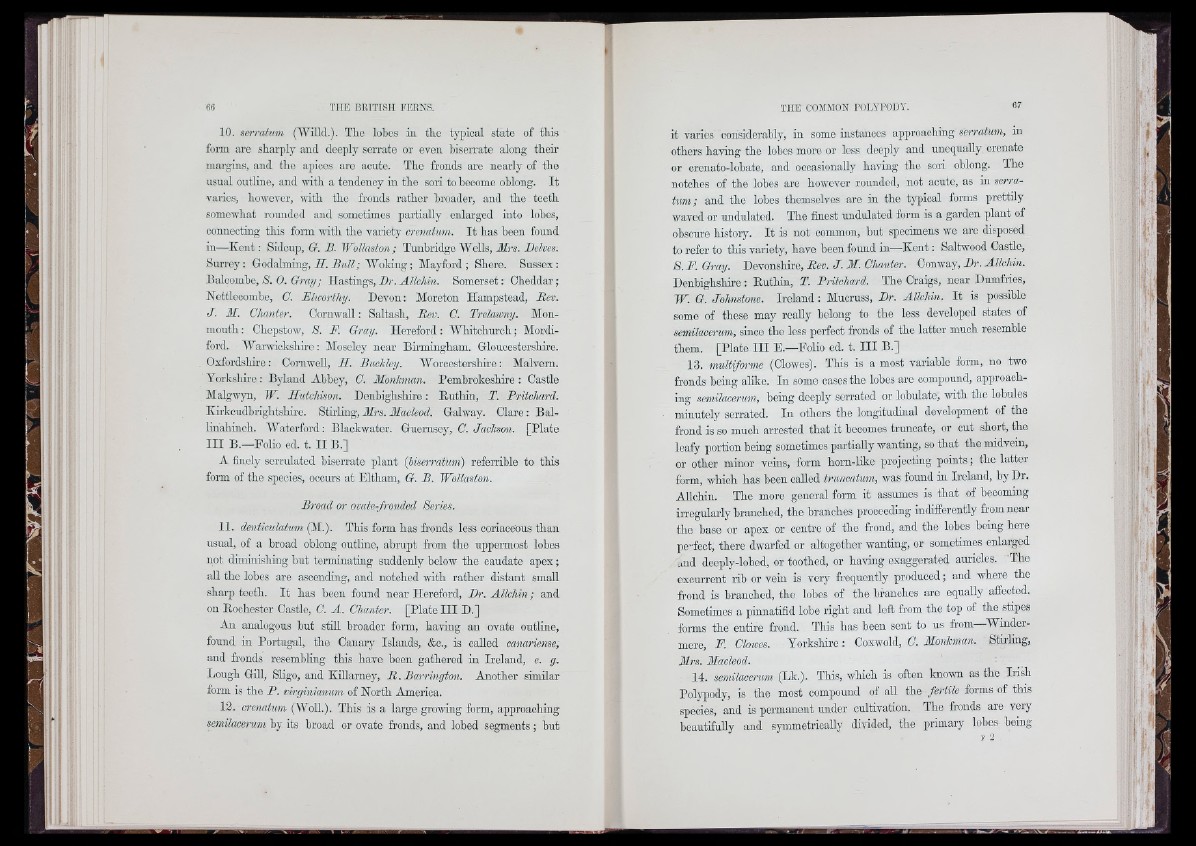
T
10. serratum ("Willd.). Tlio lobos iu the typical state of this
form aro sharply and deeply serrate or even biserrate along their
margins, and tho apices aro acute. Tho fronds arc nearly of the
usual outline, and with a tendency in tho sori to become oblong. I t
varies, however, with tho fronds rather broader, and the teeth
somewhat rounded and sometimes partially enlarged into lohcs,
oonnoctmg tliis form with the variety crcnatmn. I t has boon found
in—K e n t: Sidcup, O. B. Wollaston; Tunbridge "Wells, Mrs. Delves.
SiUTcy: Godalmiiig, H. "Woking; Mayford ; Shero. Sussex:
Ihilcomhe, 8. 0. Gray; Hastings, Dr. Allchin. Somerset: Cheddar;
Nettlecomhe, C. Elworthy. Devon: Morcton Hampstead, Bev.
J . 31. Chanter. Cornwall: Saltash, Rev. 0 . Trelatcny. Monmouth
: Chepstow, 8. F. Gray. Hereford; "Wliitchurch; Mordi-
ford. "Warwickshiro: Moseley near Birmingham. Gloucestershire.
Oxford.shiro: Cornwell, II . Buckley. "Worcestershire: Malvern.
Yorksliiro; Byland Abbey, C. 3Ionkman. Pembrokeshire : Castle
Malgwyn, W. Ilutclmon. Denbighshire: Euthin, T. Pritchard.
Kirkcudbrightshire. Stirling, Mrs. Macleod. Galway. Clare: Bal-
linahinoh. Waterford: Blackwater. Guernsey, C. Jackson. [Plate
I I I B.—Folio ed. t. I I B.]
A finely serrulated biserrate plant {hiscrraium) referrible to this
form of tho species, ocoui’s at Fltham, G. B. Wollaston.
Broad or ovate-fronded Series.
11. denticulatim (M.). This form has fronds less coriaceous than
usual, of a broad oblong outline, abrupt from the uppermost lobes
not diminishing hut tcrminatiug suddenly below the caudate apex;
all the lohcs arc ascending, and notched with rather distant smaU
sharp tooth. I t has been found near Hereford, Dr. Allchin; and
on Eochestor Castle, C. A . Chanter. [Plate I I I D.]
An analogous but still broader form, having an ovate outline,
found in Portugal, tho Canary Islands, &o., is called canariense,
and fronds resembling this have been gathered in Ireland, e. g.
Lough Gill, Sligo, and Killarney, R . Barrington. Another similar
form is the P. virginianum of North America.
12. crenatum (Woll.). This is a large growing form, approaching
semilacerum by its broad or ovate fronds, and lobed segments; but
it varies oonsiderabfy, in some instances approaching serratum, in
others having the lohcs moro or less deeply and unequally crcnate
or crcnato-lohate, and occasionally having the sori oblong. Tho
notches of the lobos aro hmvovor rounded, not acuto, as in serratum;
and tho lobos them,selves aro in the typical forms prettily
■waved or undulated. The finest undulated form is a garden plant of
obscure history. I t is not common, hut specimens wc aro duposed
to refer to this variety, have been found in—K e n t: Saltvvood Castle,
8. F. Gray. Devonshire, Rev. J . M. Chanter. Coiway, Dr. Allchin.
Denbighshire : Euthin, I . Pritchard. The Craigs, near Dumfries,
W. G. Johnstone. Ireland : Mucruss, Dr. Allchin. I t is possible
some of tbese may really belong to the less developed states of
semilacerum, sinoo the loss porfoot fronds of the latter much resemble
thorn. [Plato I I I E.—Folio ed. t. I l l B.]
13. multiforme (Clowes). Tliis is a most variable form, no two
fronds being alike. In some oases the lobos aro compound, approaching
semilacerum, being deeply serrated or lobulatc, wdth tbe lobules
minutely serrated. In others the longitudinal development of the
frond is so much arrested that it bocomos truncate, or cut short, the
leafy portion being sometimes partially wanting, so that the midvein,
or other minor veins, form horn-lilce projecting points; the latter
form, which has been called tnmcatum, was found iu Ireland, by Dr.
Allchin. Tho moro general form it assumes is th a t of becoming
irregularly branched, the branches proceeding indifferently from near
the base or apex or centre of the frond, and the lobes boing here
po’-fcct, there dwarfed or altogether wanting, or sometimes enlarged
md deoply-lobed, or toothed, or having exaggerated auricles. Tho
oxourrent rib or vein is very frequently produced; and whore tho
frond is branched, the lobes of the branches are equally affected.
Sometimes a piimatifid lobe right and loft from the top of tbe stipes
forms tbe entire frond. This has been sent to us from ^Winder-
mere, F. Clowes. Yorkshire; Coxwold, C. Monkman. Stirling,
Mrs. Macleod.
14. semilacerum (Lk.). This, which is often known as the Irish
Polypody, is the most compound of all the fertile forms of this
species, and is permanent under cultivation. The fronds are very
heautifuUy and symmetrically divided, the primary lobos being
i , ;
fij ! | f
^'1
»
A •
i ^ I
h i